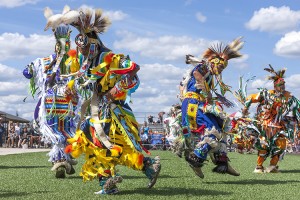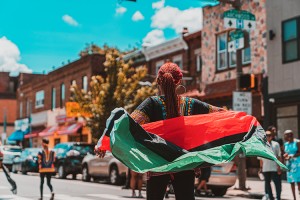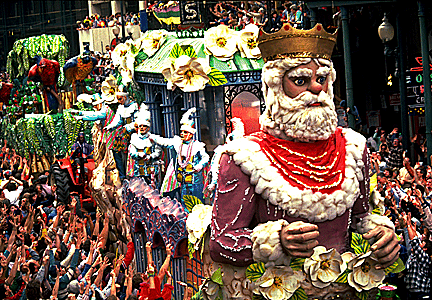Native American Heritage Month: Powwows
Wednesday, November 22nd, 2023
Young dancers participate in a Powwow on July 23, 2016, in Couer d’Alene, Idaho.
Credit: © Gregory Johnston, Shutterstock
People in the United States observe Native American Heritage Month each year in November. During this period, many Native tribes celebrate their cultures, histories, and traditions. It is also a time to raise awareness of the challenges Indigenous people have faced in the past and today, along with their contributions to the United States as its first inhabitants.
Across the country, people are gathering for powwows big and small to celebrate Native American Heritage Month. Through dancing, traditional food and regalia, and other traditions, Indigenous communities celebrate their culture and community. For many communities, these will be the first large powwows held since the COVID-19 pandemic began in March 2020. The Choctaw Nation hosted one of the country’s largest and most well known powwows in Oklahoma earlier in the month. Some powwows honored Indigenous veterans on Veterans Day.
A powwow is a ceremony of dancing practiced by Indigenous (native) peoples of the United States and by First Nations, Indigenous peoples of Canada. The term powwow comes from the Algonquian word pau wau, meaning healer. The gathering lasts several days and includes dancing, drums, feasts, regalia (traditional attire), and singing. Powwows have their roots in traditional Indigenous religious ceremonies and meetings. Today, they may serve as a secular (nonreligious) and public celebration.
Indigenous American cultures included traditional dances and songs. However, many Indigenous ceremonies and traditions have been outlawed by white settlers at various times. In the United States, the Religious Crimes Code of 1883 prohibited ceremonial dances. The Indian Act, first passed in 1876, is the main Canadian law governing relations between the First Nations and the federal government. In 1884, the act was amended to ban ceremonies such as potlatches and certain dances. The potlatch is a ceremony of feasting and gift-giving practiced by indigenous peoples and First Nations of the Northwest Coast region.
In the late 1800’s, traveling “Wild West” shows became popular. Shows such as that presented by the frontiersman and entertainer Buffalo Bill offered an opportunity for Indigenous performers to make money for their tribes by performing outlawed songs and dances publicly.
The Religious Crimes Code was amended to allow Indigenous dances and songs in 1933. In 1951, Canada lifted the prohibition on dances and potlatches. The United States Congress passed the American Indian Religious Freedom Act in 1978 to guarantee the protection of Indigenous people under the First Amendment to the Constitution. These changes enabled powwows to flourish in the 1960’s and 1970’s, when they were held during the summer.
Smaller local powwows still occur on reservations (lands set aside for Indigenous use), but larger powwows may take place in stadiums and at casinos. Indigenous elders bless the grounds before the event begins through song, prayer, and the burning of sage or tobacco. The powwow grounds are usually laid out in a series of concentric circles (circles spreading from a common center). The area for dancing and drums lies in the middle. The space around the dancers is reserved for elders and friends and family of the dancers. Outside that circle, there is room for spectators and vendors. The vendors sell traditional and modern foods, crafts, art, and clothing.
Every powwow has an emcee, a master of ceremonies. The emcee is usually a leader in the community with knowledge of the traditional ceremonies along with a modern-style education. The emcee announces events, introduces dancers, and tells stories.
Powwows begin with the grand entry, an opening parade. This tradition was adopted from the Wild West shows as well as processions at treaty signings. In a giveaway ceremony on the last day of the powwow, gifts are given from the host to the visitors or in memory of someone who died. The ceremony begins with the hosts dancing and the emcee announcing those receiving gifts.
Dancing styles are differentiated in part by the regalia worn by performers. Competitive dances for men include the fancy, grass, northern, and straight dance styles. For women, competitive dancing styles include fancy shawl, jingle dress, northern and southern buckskin, and northern and southern cloth. Dancers compete for prize money. The dance competition is organized by dance style and by the age and gender of the performers.
Drums and singing accompany the dances. Singers may sing in the language of a specific tribe or in vocables, simple nonverbal syllables that are shared among tribes.
Powwows are held the year around in major cities across Canada and the United States. A powwow may include up to 800 dancers or more. Some traditional powwows focus only on the songs and dances. Others may include such activities as rodeos, fashion shows, and music competitions. The largest powwow is the Gathering of Nations in Albuquerque, New Mexico, which may include more than 3,000 dancers.





